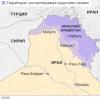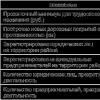How to put overtime on the time sheet. What to put on the report card with irregular working hours? Entering the number of hours of overtime
How to show overtime in the timesheet if the timesheets are not showing up on the timesheet. And here's the situation: Was the car driver involved in overtime work at night in the amount of 4 hours (it was Friday) and on the day off (Sunday) in the amount of 4 hours? Thank you.
Answer
If only cases of deviations from the normal use of working hours established by the internal labor regulations are registered in the report card. In the upper half of the line, for each employee who had deviations from the normal use of working time, the hours of deviations are recorded, and in the lower half - the symbols of deviations.
If one employee of the institution has two types of deviations in one day (period), the lower part of the line is written as a fraction, the numerator of which is a symbol for the type of deviation, and the denominator is the hours of work. If there are more than two deviations in one day, the name of the employee is repeated in the report card.
Thus, we can say that overtime work in this case will be a deviation from the generally established regime in the institution. Consequently, in the upper half of the line for each employee who had deviations from the normal use of working time, the hours of deviations are recorded, and in the lower half - the symbols of deviations (for example, 4 / C)
Overtime hours are noted as - S.
Details in the materials of the System Personnel:
1. Answer: How to fill out a timesheet according to the form No. 0504421
N.Z. Kovyazina
In budgetary organizations and institutions, the standard form of the timesheet is used.
The timesheet is used to record the use of working hours or to register various cases of deviations from the normal use of working hours. The choice of the method of filling out the timesheet is fixed in the local act as part of the formation of the accounting policy of the institution.
The report card is filled in by the responsible person appointed by the order on a monthly basis as a whole for the institution or in the context of structural divisions: departments, divisions, faculties, laboratories, etc., and separate divisions: branches.
The timesheet is opened monthly 2-3 days before the start of the billing period based on the timesheet for the last month.
Changes in the payroll of employees in the timesheet are made on the basis of documents for accounting for labor and its payment: orders for appointments, dismissals, etc.
There are only two fundamental differences.
The first point is that now the timesheet can indicate both cases of deviation and the actual cost of working time. The specific method of filling out the timesheet is determined by the institution itself.
The second point is the "account number" of the employee (columns 2, 3). The accounting moment is the identifier of information about an individual, such as a personnel number or SNILS (Methodological recommendations given in). Therefore, in column 2, the employee's personnel number should be put down, and in column 3 - SNILS.
If necessary, the institution has the right to make changes or additions to the timesheet form (Procedure approved).
An example of filling out a timesheet according to form No. 0504421
Personnel specialist I.А. Ignatieva filled out, signed and submitted it to the accounting department.
Let's consider how overtime work is registered and formalized in the program. To do this, you need to follow several steps:
- register the occurrence of the need for overtime work, obtain the consent of employees to work overtime;
- record the number of overtime hours worked by each employee;
- issue an overtime order.
These actions can be performed by one user, for example, a personnel officer, or shared between a personnel officer and a timekeeper.
Registration of the need for overtime work, obtaining the consent of employees
To register the need for overtime work, i.e. work in excess of the employee's schedule, the 1C: ZUP 3 program uses a document Working overtime (Human Resources - See Also - Overtime Work or Salary - Time Tracking - Overtime Work). With the help of this document, an order for overtime work is also drawn up.
Month and date of the document
In the props Month the month of accrual is indicated in which the payment for overtime work should be charged, in the requisite date- date of issue of the order for overtime work.

Working days
In the tabular section Working days the days when overtime work will be done.

Reason for overtime
In the props Reasons, justification for overtime work the reason for such work is indicated. Information from this requisite will go into the printed form of the overtime order.
Employees who will work overtime
In the tabular section Overtime hours employees who will work overtime are indicated. At this stage of working with the document, the number of overtime hours is not entered, since it is assumed that the document is registered in advance and the exact number of overtime hours is not yet known.
Overtime Consent
After obtaining consent, the checkbox is checked in the document Overtime consent received :

Compensation method
If time off accounting is enabled in the program settings, then the column is displayed in the tabular section of the document Compensation method , in which you can specify how the employee should be compensated for overtime work: increased pay or regular pay and time off.
Entering the number of hours of overtime
The actual number of overtime work is recorded in the document Working overtime user with profile Timekeeper... It does not have to be a separate special user, the timesheet profile can be assigned to the HR specialist along with the main profile Personnel officer... If the user has timekeeper rights, then in the tabular section Clock overtime work he will be able to enter overtime hours.
If the program is configured to work for users with different access profiles, then the document displays the flag Time taken into account ... It must be installed in order to complete the execution of the document. Only after checking this box and posting the document will the overtime hours be recorded in the timesheet.

Overtime order stamp
Working overtime PDF
Overtime schedule PDF
After entering the number of hours of overtime from the document Working overtime you can form a printing plate Overtime order PDF
A printable is also implemented for the document Overtime schedule PDF
Reflection of overtime work in the timesheet
In the time sheet, overtime work is reflected with an indication of the number of overtime hours worked:
- letter WITH- with the method of compensation Increased payment;
- letters CH- with the method of compensation without increased payment with the provision of an additional day of rest. Letter designation CH is not regulated, introduced by the developers to distinguish overtime hours for which an increased payment is not required, such hours are paid in a single amount.

Check the date of formation of the timesheet: if it is less than the date of overtime work, then overtime work will not be reflected in the timesheet. In this case, set a later date for the report in the report settings:

Possibility of registration of overtime by document Time sheet
In the program, you can register overtime work and using the document Report card, in this case document input Working overtime not required. Payment for overtime work in the program is made on the basis of the recorded types of time, which can be registered by any of the documents Working overtime or Report card .
The letter designation is used to register overtime hours with increased pay. WITH .

Overtime without increased pay is recommended to be entered through the document Working overtime , since in this case, not only the time of overtime work must be registered, but also time off, and the document Report card to take into account time off "does not know how."
The legislation of the Russian Federation requires the employer to strictly and conscientiously take into account the duration of working hours and overtime hours worked. Labor Code Article 99 regulates the procedure for overtime work: the concept, duration, regulation of situations when an employee must give, and which situations are considered urgent and consent is not required. Among the types of accounting are: order, statement and journal.
According to Article 99 of the Labor Code of the Russian Federation, work is considered overtime when it is performed by order of the head and exceeds the employee's working time.
Overtime work is documented mandatory or time sheet.
The log book is an optional arbitrary form of accounting for excess time, which indicates the name of the employee, the number of overtime hours, and the date of completion.
Article 99 of the Labor Code states that the employer must make accurate accounting, but in what form this accounting must be done is not specified. Legislatively, the rules or form of logging are not enshrined in any normative act.
- Every day. The classic calculation of the schedule in the event that employees come to work every day. The average number of hours per day is calculated. For most staff with a 5-day stay, this is at least 8 hours. Accounting is done by the day. More than the specified interval is considered overwork.
- Once a week. It occurs when employees work out all the standard hours fixed in the contract in a week. Overtime will go to work done beyond that. The journal is filled once a week.
- Summed up. Such time counting is convenient in the situation of a round-the-clock enterprise, with a rotational work method of employees. Norms and excess marks are indicated once a month, in two, six months, or in another convenient period for the manager.
What is a magazine for?
Does not apply to mandatory documentation. At the same time, many managers and personnel officers use this method of accounting, since the document:
- registers cases of work performed by employees in excess of the standardized labor regime
- streamlines the recruitment of employees to overtime work
- simplifies the procedure for calculating the monetary reward
- controls compensatory payments in the form of cash rewards or time off
Rules of conduct
The Labor Code does not regulate either the procedure for maintaining or the appearance of the journal. Each company independently establishes accounting rules. Keeps a journal depending on the staff:
- supervisor
- deputy
- another designee
The job description indicates the fact of logging.
Significant nuances when filling out:
- accounting must be accurate, since compliance with Russian legislation depends on this (no more than 4 hours over 2 days in a row, 120 hours per year)
- delay at work at the employee's own request is not counted as excess time and, accordingly, is not paid
- the magazine on the last page must have a place for the signature of the witness
- it is more convenient to have several lacing holes in the document, but it should not be laced
The following information must be entered into the table:
- Full name of the employee
- reason for overtime
- number of hours worked
- details of written consent
It is not necessary to indicate in the journal (money or time off), since the decision of the staff may change and you will have to redo / correct the document.
Samples of required documents
Any overtime work starts with an order. If necessary, obtain the consent of the employee, recorded on paper, and / or the trade union. Only after the work has been done is the data entered into the log.
Order

The order, like any other document, must have:
- "Cap"
- input data (name, date, number)
- the main part
- conclusion (name, signature)
Report card

Overtime is referred to as "C" or "04" throughout this document. The column in which this type of work is indicated is at number 4 (form No. T-13) or 6 (form No. T-12). A number is placed under the pointer indicating the number of hours worked overtime.
Magazine
The accounting journal has an arbitrary form, convenient for a particular organization. One of the examples of the introduction of an accounting document is in the figure.

The Labor Code of the Russian Federation states that the head is obliged to carry out his employees. In what form it is not regulated by law. The journal is an optional, but convenient and useful form of accounting for overtime work for the manager.
Write your question in the form below
Read also:
 Summarized accounting of working hours is what: ...
Summarized accounting of working hours is what: ...
 Dates of dismissal for absenteeism and the mechanism of parting with ...
Dates of dismissal for absenteeism and the mechanism of parting with ...
Consultation provided on 05/06/2015
The organization uses the unified form of the timesheet N T-12. An employee on 04/29/2015 goes to the night shift. The shift starts on 04/29/2015 at 23:00 and ends on 04/30/2015 at 06:00.
Since 04/30/2015 is a shortened working day, the employee remains for 1 hour of overtime. The hour of this overtime work falls into the night. The summarized recording of working hours for the specified employee has not been established.
1. How should you pay for this hour - just as overtime or else to charge the night for this hour?
2. How to reflect this situation in the report card?
The overtime hour on a pre-holiday day that falls at night is payable both as overtime and night work.
Overtime pay at night
Article 95 of the Labor Code of the Russian Federation
According to the first part of Art. 95 of the Labor Code of the Russian Federation, the duration of a working day or shift immediately preceding a non-working holiday is reduced by 1 hour. This rule applies to all employees, regardless of the length of the working week established by them, which was confirmed by the Supreme Court of the Russian Federation in its decision of September 29, 2006 N GKPI06-963. This means that the duration of work on the eve of the holiday should be 1 hour less than usual, including for part-time workers, as well as persons with part-time or reduced working hours.
Overtime Compensation
In continuously operating organizations and on certain types of work, where it is impossible to reduce the duration of work (shift) on the pre-holiday day, overwork is compensated by providing the employee with additional rest time or, with the employee's consent, by payment according to the norms established for overtime work (part two of Article 95 of the Labor Code RF). Accordingly, in such a situation, the overtime hour must be compensated for by providing the employee with additional rest time, or the employee may agree with the employer's proposal to pay for overtime work.
Overtime work is paid for the first two hours of work not less than one and a half times, for the next hours - not less than double. Specific amounts of payment for overtime work can be determined by a collective agreement, local regulation or labor agreement (Article 152 of the Labor Code of the Russian Federation).
Payment for work at night
Work at night (from 22:00 to 6:00) is paid at an increased rate (every hour of work at night) (part one, article 154 of the Labor Code of the Russian Federation). The minimum increase is established by RF Government Decree of 22.07.2008 N 554 and is 20% of the hourly wage rate (salary calculated per hour of work) for each hour of work at night. The specific amounts of the increase in wages for work at night are established by a collective agreement, a local normative act adopted taking into account the opinion of the representative body of workers, an employment contract (part three of article 154 of the Labor Code of the Russian Federation).
However, the rules for overtime pay do not override the rules for increased pay for night work. Article 154 of the Labor Code of the Russian Federation applies to any night work performed both during working hours and outside it (overtime, on weekends and non-working holidays). Therefore, for an employee who worked overtime at night, the employer is obliged to make two compensation payments at the same time - under Art. 152 and under Art. 154 of the Labor Code of the Russian Federation.
Thus, the hour of processing on the pre-holiday day, which fell at night, is payable both as overtime work (Article 152 of the Labor Code of the Russian Federation) and as work at night (Article 154 of the Labor Code of the Russian Federation). Moreover, both of these compensations are provided independently, independently of each other (see, for example, the decision of the Neryungrinsky City Court of the Republic of Sakha (Yakutia) of 15.07.2010 in case No. 2-1315-2010).
Marking overtime work at night on the report card
Time sheet
The employer is obliged to keep records of the time actually worked by each employee (part four of article 91 of the Labor Code of the Russian Federation), including the time worked outside the established duration of the working day (shift).
Unified form N T-12 (timesheet) was approved by the decree of the State Statistics Committee of Russia dated 05.01.2004 N 1. The same document approved the Instructions on the use and filling out of forms of primary accounting documentation on labor accounting and its payment (hereinafter referred to as the Instructions), which regulate the procedure for filling out the timesheet.
According to the Instructions, to reflect the daily costs of working time for a month for each employee, there are two lines in the report card of form N T-12 (columns 4, 6). The upper line is used to mark the symbols (codes) of the costs of working time, and the lower line is used to record the duration of the worked or unworked time (in hours, minutes) according to the corresponding codes of the costs of working time for each date. If necessary, it is allowed to increase the number of columns for adding additional details for the working hours.
Symbols
Symbols of worked and unworked time are presented on the title page of form N T-12. In particular, the following letter codes have been established: "H" (to indicate hours worked at night), "C" (to indicate overtime worked).
Thus, the following marks are put on the report card:
Prepared answer:
Expert of the Legal Consulting Service GARANT
Naumchik Ivan
Quality control of the response:
Reviewer of the Legal Consulting Service GARANT
As of: 10.12.2010
Magazine: Everything for the HR officer
Year: 2011
Author: Anna Batura
Topic: HR documents, Irregular working hours
Rubric: Have a problem? Here is the solution
- Document templates
- Timesheet Journal
Regulations
- Labor Code of the Russian Federation (extract)
- All work books burned out. What to do?! Providing strictly scheduled vacations Employer branding - a new fashion or the future of HR?
Last month our chief accountant changed. And everything would be fine - he establishes contact with the personnel department, he gets the job done. But on some issues we cannot come to a consensus. For example, such a problem. We have employees in our company who work in irregular working hours. For this, as it should be, we provide them with additional leave. In the time sheet, such workers have always been given "eights". And the new chief accountant claims that the days when they are overworking must be recorded in the report card, because we are obliged to keep accurate records of the time worked by each employee. Have we done it wrong the whole time?
Irregular working hours are a special mode of work in which employees, by order of the employer, are occasionally involved in work outside the normal working hours.
The compensation for such a mode of work is not an increased salary, but an annual additional paid leave of a certain duration, but not less than three calendar days.
The question of how to record work in the regime of irregular working hours, in practice, causes many problems. On the one hand, the employer is indeed obliged to keep accurate records of the time actually worked by each employee. This is directly stated by the Labor Code of the Russian Federation (part 4 of article 91 of the Labor Code of the Russian Federation). Your chief accountant is absolutely right about that.
On the other hand, such overtime, unlike, for example, overtime work, employees are not paid. In this regard, the question arises: how to simultaneously fulfill your obligations for recording hours worked and not get confused in payment? Let's get a look.
So, for those who work in irregular working hours, the number and duration of overtime work in excess of the established working time does not affect the amount of wages and the duration of their additional vacation.
Time tracking allows you to control labor discipline, monitor the stay of employees at work places, and, if necessary, decide the place and time of some incidents, for example, industrial accidents, etc. violation of labor legislation in the form of systematic involvement of the employee in the performance of labor functions outside the established working hours for them. As we have already noted, irregular working hours are sporadic work and should not turn into a system of overwork.
As a general rule, a time sheet is used to record the time worked by each employee. It has a unified form No. T-12 or No. T-13, approved. Resolution of the Goskomstat of Russia dated 05.01.2004 No. 1 "On the approval of unified forms of primary accounting documentation for labor accounting and remuneration" (hereinafter - Resolution of the Goskomstat of Russia dated 05.01.2004 No. 1).
The purpose of this document is defined in the Instructions for the use and filling out of forms of primary accounting documentation, approved. Resolution of the State Statistics Committee of Russia dated 05.01.2004 No. 1.
Time sheets are drawn up in one copy by an authorized person, signed by the head of a structural unit, an employee of the personnel service, and then transferred to the accounting department for calculating wages. Thus, the amount of the employee's remuneration will depend on the duration of the working time fixed in this document. And we have already found out that work in the regime of irregular working hours does not affect wages.
Our reference
In the event that an irregular working day regime is established for an employee, keeping records of the time actually worked by him outside the established working hours is not necessary at all in order to "justify" the granting of additional paid leave to the employee. Unfortunately, this opinion is sometimes found even among the inspectors from the GIT, but it is erroneous.
Additional paid leave is granted to employees for whom an irregular working day is established, for the very possibility of their occasional involvement in work outside the established working hours. The employee's right to such leave does not depend at all on how many times and for how long they stayed after work during the year for which the leave is granted. Such paid vacation days should be granted to employees whose positions are included in the list of employees with irregular working hours, even if during the year they have never fulfilled orders from management outside the normal hours of their working day.
The presence and duration of processing does not affect the duration of the additional paid leave provided. The number of its calendar days is fixed in the local regulations of the employer or in the collective agreement, and is also necessarily indicated in the employment contracts of employees.
YOU MUST KNOW IT
The time sheet is the document the basis for calculating the employee's wages
The time sheet reflects the time spent working under abnormal conditions when it is associated with additional pay. For example, the time sheet takes into account the hours of overtime, night work, weekends and non-working holidays.
But to fulfill the obligation under Part 3 of Art. 91 of the Labor Code of the Russian Federation, it is possible not only with the help of the timesheet. When an employee works on irregular working hours, occasional overtime should be taken into account in any other way that the employer chooses. For such accounting, you can maintain, for example, a journal for recording the working hours worked by employees in the irregular working day mode. Let's see an example.
EXAMPLE 
For HR inspector Gavrilova A.P., a regime of irregular working hours has been established, which is compensated by four calendar days of additional annual paid leave.
By order of the head of the organization, the HR inspector carried out an urgent assignment outside of her working day on January 17, 2011. To prepare for the audit, she, with written consent, was involved in overtime work on January 28, 2011.
In the timesheet, the upper line is used to mark the symbols (codes) of the costs of working time, and the lower line is used to record the duration of the hours worked (in hours, minutes) according to the corresponding codes of the costs of working time for each date.
On January 28, overtime work was recorded in the report card (the working time on that day was 10 hours), while overtime in the mode of irregular working day 1 January 7, 201 1 was not noted in the report card in any way example 1). Moreover, the duration of work on behalf of the head on the specified day is recorded in a special journal ( example 2).



















